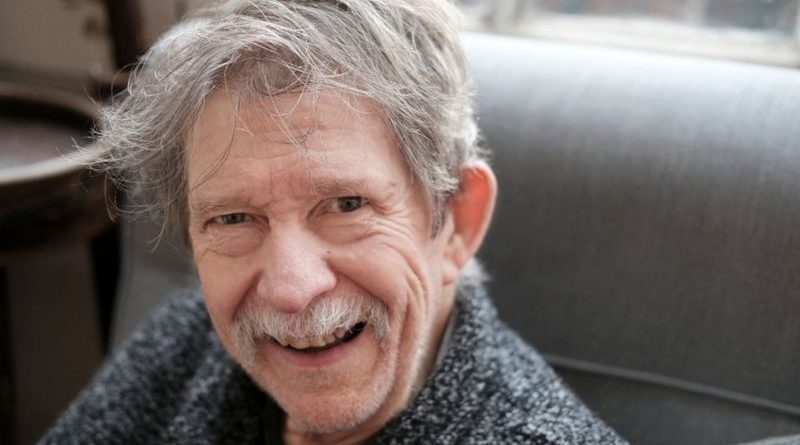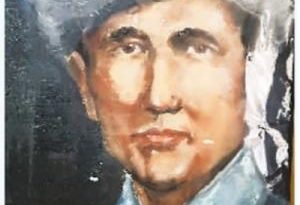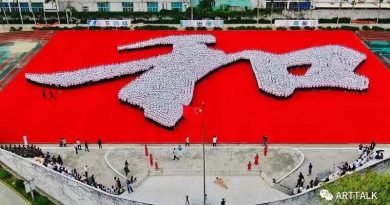“社交网络之父” 海恩斯:敞开家门结交天下客的传奇人生
Jim Haynes: A man who invited the world over for dinner
BBC新闻记者 薇琪·贝克尔(Vicky Baker)
2021年1月31日

图片来源:Jesper Haynes
吉姆·海恩斯(Jim Haynes),一个以巴黎为家的美国人,既是摇摆六十年代的偶像,也是摇摆六十年代的遗迹,因邀请成千上万的陌生人到他家吃饭而闻名。他在2021年年初时去世了。
2020年2月,我在新冠疫情封城前最后一次出国旅行。我临时起意,突然想和朋友一起吃顿饭,于是便买了一张票,跳上了去巴黎的欧洲之星火车。吉姆·海恩斯已经80多岁,身体健康一天不如一天,但我知道他一定会欢迎我的来访。任何人想去看他,吉姆总是热忱欢迎。
那次旅行的精妙之处现在回味起来,就仿佛疫情时代的对立面。在一个潮湿的冬夜,他位于巴黎14区的工作室里发出温暖的光芒,吸引了我和其他客人。屋内,人们肩并肩地挤在狭窄的厨房里。从未谋面的人们聊了起来,三五成群,用纸盘托着晚餐,互相帮忙从共享酒盒上的塑料瓶口里取酒。
空气中总弥漫着热闹的气息,来自四面八方的人——本地居民、外来移民、旅行客们,都在这个狭小的开放式空间里聚集混杂。一锅丰盛的食物在灶上煮得热气腾腾,然后分盘摆在一张大板桌上,大家都自取一份,边吃边继续聊着。
吉姆被称为“社交网络教父”是有原因的。早在人们都把社交活动承包给美国硅谷的科技大公司之前,吉姆就走在了前面,成为陌生人联系的纽带。
 图片来源:Jesper Haynes
图片来源:Jesper Haynes
我认识吉姆的时候,他已经年纪大了,但是他的一生过得极不寻常。1933年,他出生在美国的路易斯安娜,十几岁时曾在委内瑞拉生活,之后在伦敦成立了另类文化中心“艺术实验室”( Arts Lab),在那里他交往的都是英国文化界的名人,其中包括摇滚巨星大卫·鲍伊(David Bowie)、披头士之一的约翰·列侬(John Lennon)以及他的日本裔太太小野洋子(Yoko Ono);之后他还在阿姆斯特丹经营过一本性解放杂志。1969年他在巴黎一所大学任教,成为研究性政治的讲师,从此定居在这个城市。
然而,他却经常被视为苏格兰之子,在1950年代末和60年代末,他在爱丁堡创办了第一家平装书书店,还合伙创建了Traverse剧院,并且帮助发起了爱丁堡艺穗节(Fringe Festival),是一个有相当影响力的人物。
2021年年初,吉姆去世了,享年87岁。报纸上的讣告称他为 “苏格兰垮掉一代的非正式经理人”。
虽然很多德高望重的人在功成名就后往往会隐退到自己的小圈子里,但吉姆却从来没有停止过结交新朋友。我第一次与他联系是在2008年,当时突然收到一封电子邮件。
我在巴塞罗那的报纸上写了一篇文章,不是写西班牙的那篇,而是有关委内瑞拉海岸的那篇。这篇文章让他回忆起了自己的少年时代。他的父亲在石油行业工作,吉姆十几岁的时,他们举家搬到那里。
我的文章是关于通过“沙发冲浪”网站(Couchsurfing)结识朋友,委内瑞拉人把家免费开放给世界各地的陌生旅客们。这是在爱彼迎(Airbnb)研究出如何将这一理念赚钱赢利之前。非商业化的文化交流概念与吉姆的想法不谋而合。
 海恩斯在伦敦期间结交许多的英国文化界的名人,其中包括摇滚巨星大卫-鲍伊(David Bowie)。图片:PA Media
海恩斯在伦敦期间结交许多的英国文化界的名人,其中包括摇滚巨星大卫-鲍伊(David Bowie)。图片:PA Media
他在电邮里写道:“回欧洲时,过来吃晚饭吧。” 他承诺会告诉我他自己的一个老旅行项目,他觉得我可能也会喜欢。
我当然很感兴趣,回来后不久就去了巴黎。想象中与他这样的文化精英的晚餐应该是比较私密的,但到了我才发现其实更像是学生时代的宿舍聚会,尽管与会者比学生们成熟得多,而且酒也喝得很有节制(吉姆本人滴酒不沾,聚会在晚上11点之前准时结束)。
一见面,吉姆像老朋友一样和我打招呼,我们聊着聊着,他伸手到客厅的书架上给了我一本书。封面上写着《人与人》。这就是他想告诉我的项目。
他解释说,在20世纪80年代末,他为铁幕下的国家创办了一个旅游指南系列。这个指南看着就像一本地址簿,并没有标准的景点介绍和酒店列表,而是数以百计的愿意接待游客的房东名单。他的想法是,如果人们不能亲眼去看西方世界,他将通过旅行者把西方带到他们面前。这其实就是“沙发冲浪”网站的理念,不过却是线下的。
 吉姆·海恩斯与儿子杰斯珀。 图片:Viveka Reuterskiöld
吉姆·海恩斯与儿子杰斯珀。 图片:Viveka Reuterskiöld
他递到我掌心上那本旅游指南,手掌大小,重点介绍波兰。我很喜欢,决定去一趟,看看在发生了那么多变化之后,当年的参与者是否仍然愿意接待随兴而去的访客。
所有房东按照所居的城镇排列,后面还有两三行字,包括地址、出生日期、电话号码和爱好。通过谷歌搜索和慢得像蜗牛一样的邮寄信,我设法找到了其中的几个人。大多数人都知道吉姆,要么认识他本人,要么是他朋友的朋友。所有的人都对这个项目有着美好的回忆,并且仍然愿意给我当向导,带我四处参观。
在格但斯克,我问公务员克里斯蒂娜·瓦罗布鲁斯卡(Krystyna Wróblewska),她当初为什么愿意参加这个项目。她告诉我,她一直帮媒体做事,帮助过记者报道反共产主义的船厂罢工。“媒体拍回来的总是那些头上绑着手帕的女人和拉着车的马,永远给你看老一套的照片,我想见见普通人,打破程式化的形象,也想显示你脑子里的那些画面有的其实与现实有很大的差距。”
吉姆告诉我,“我没想到这份旅行指南办起来那么简单容易”。他先后为罗马尼亚、捷克斯洛伐克、匈牙利、波罗的海国家和俄罗斯都制作了指南,介绍了成千上万的当地人。他有很多本通讯录,其中有些就进了指南。他接受这些国家当地的报纸和爵士乐杂志采访后,又添加了很多新联系人。
他说:“俄罗斯的一些老年人害怕被列入西方人的名单,因为他们担心这会更容易被抓起来送走。”
“但是很多年轻一代的人都愿意列在这本指南上。我收到了一袋袋的信。我敢肯定,街道邮递员很想知道为什么有这么多人写信给我。”
 Getty Images
Getty Images
多年来,当局经常想知道吉姆在住处究竟在干些什么。尤其是在他开始签发假护照的那段时间。那是在20世纪70年代,他发现有一个在20年前放弃美国国籍的旅行者制作了自己的 “世界护照”。
对吉姆来说,不属于任何国家的护照似乎囊括了他和平与全球自由的理想。于是,他把自己的家变成“大使馆” ,开始为任何需要护照的人发放世界护照。这些护照看上去那么像真的,有些人还用它们通过了国境边检。法国警察非常恼火,找上门来说:“你不能再这么做了,必须住手。”
但吉姆没把警察当回事,结果被告上了法庭。虽然他被指控的诈骗和造假的罪名并不成立, 但他还是被定了“混淆视听误导公众”的罪。
吉姆一惯不觉得这事做得过于天真,但据他的一些朋友说,他对人太过信任,这导致了多年来的财务麻烦和和法律官司。而且他有问题不抓紧应对,总是等到问题闹大了才处理。
他的儿子杰斯珀(Jesper)说,“我经常要拦着他,不让他签字。有时候他连看都不看就签。”
杰斯珀是1960年代吉姆和薇薇卡·鲁特斯科尔德(Viveka Reuterskiold)婚姻期间出生的儿子。
父母分居后,杰斯珀在斯德哥尔摩长大,但从10岁起他每年夏天都会去巴黎。
他回忆早年去巴黎时说:“地板上空出的地方都放着床垫,客人在家里每个地方打地铺睡觉。很刺激,很好玩,但我有时候也很嫉妒。很多人都嫉妒。每个人都想多占些他的时间,每个人都想把他据为己有,但他根本不归任何人所有。”
 吉姆·海恩斯自己从不做饭,会请来客自己做。图片:Vicky Baker
吉姆·海恩斯自己从不做饭,会请来客自己做。图片:Vicky Baker
1990年代,随着嬉皮士一代的老去,到巴黎参加他晚餐的人流开始减少。但随后,新一波的年轻游客开始与他接触。世界各地的博主们也发现了他。
过去几十年一直帮着吉姆办周日晚餐的好朋友西马斯·马斯温尼(Seamas McSwiney)说:“互联网既毁了晚餐,也救了晚餐”。
“它变得不那么顺其自然了,因为大家都会提前六个月预订,这跟吉姆的出行方式有冲突,也很烦人,因为那些人不来的可能性更大。不过,网络上登的那些文章又让他的想法有了新的活力,有了年轻人的加入,有了新的动力。”
吉姆最多一次招待过120个客人,他的工作室真是挤得满满的,连后花园里都是人。这些年累计起来,应该有15万人来他这里吃过饭。
曾跟吉姆一起住过一年半的澳大利亚记者阿曼达·莫洛(Amanda Morrow)说:“门永远是开着的。对客人来说,这就是一个旋转推门,有些人进来后想留下来,有些只是进来打个招呼。吉姆从不拒绝任何人。”
杰斯珀说:“让吉姆难过的唯一一件事就是大家都走了。他受不了这个。他不喜欢自己呆着,好在通常都会有新人来分散他的注意力。”
到了晚年,其他人都被他吸引过来时,吉姆会静静地坐着。我最后一次去看他时,他显得很虚弱,受着各种病痛的折磨,但他看上去还是很满足的样子,显然永远不会厌倦做一个人与人沟通的纽带。
他对我说:“我还在想你什么时候再来呢” 。他声音有些沙哑,不知道为什么这么多年美国口音一点也没改。
这是一个曾与列侬和鲍伊共处的人,他曾是索尼娅·-奥威尔的朋友,还曾与塞缪尔·贝克特一起在巴黎散步。但他却让每个人都感到特别,让每一次的联系都很重要。
好友西马斯说:“这感觉像是政治家才会玩的把戏,但对他却很自然。”
最近一段时间里,新冠病毒隔离规定让聚餐受到很大的限制,但他的朋友们说,他并没有因为疫情而沮丧。他觉得聚餐肯定有天会恢复,在那天还没来之前,他仍然享受着护理人员的探访和尽可能去看他的朋友们的问候。
1月6日他在睡梦中去世,网上悼念铺天盖地。
在所有的哀悼怀念声中,杰斯珀的一番话尤其令人动容:“他早就定下了人生目标,要介绍全世界的人彼此认识,他差不多成功如愿了。”
文章来源: BBC中文网 于
Jim Haynes: A man who invited the world over for dinner
By Vicky Baker, BBC News
Published 24 January, 2021

Jim Haynes was both an icon and a relic of the Swinging Sixties, an American in Paris who was famous for inviting hundreds of thousands of strangers to dinner at his home. He died this month.
Last February, I took my last trip abroad before lockdown closed in on us. I bought a last-minute ticket and jumped on the Eurostar to Paris, motivated by a sudden urge to have dinner with a friend. Jim Haynes had entered his late ’80s and his health was declining, yet I knew he would welcome a visit. Jim always welcomed visitors.
The essence of that trip now feels like the antithesis of Covid times. I was far from the only guest wandering into the warm glow of his atelier in the 14th arrondissement on a wet winter’s night. Inside, people were squeezing, shoulder to shoulder, through the narrow kitchen. Strangers struck up conversations, bunched together in groups, balancing their dinners on paper plates and reaching over each other to press the plastic spout on a communal box of wine.
Jim had operated open-house policy at his home every Sunday evening for more than 40 years. Absolutely anyone was welcome to come for an informal dinner, all you had to do was phone or email and he would add your name to the list. No questions asked. Just put a donation in an envelope when you arrive.
There would be a buzz in the air, as people of various nationalities – locals, immigrants, travellers – milled around the small, open-plan space. A pot of hearty food bubbled on the hob and servings would be dished out on to a trestle table, so you could help yourself and continue to mingle. It was for good reason that Jim was nicknamed the “godfather of social networking”. He led the way in connecting strangers, long before we outsourced it all to Silicon Valley.

Jim Haynes’ Paris dinners as seen from the mezzanine aboveimage copyrightMichael Kurcfeld
image captionA ballet dancer staying with Jim in the late 1970s suggested cooking for him and friends to repay the hospitality; the dinners became weekly for 40-plus years. Photo:Michael Kurcfeld
I only knew Jim in his later years, but his entire life was extraordinary. Born in Louisiana in 1933, he had lived in Venezuela as a teenager; founded the alternative culture centre Arts Lab in London, where he mixed with David Bowie, John Lennon and Yoko Ono; ran a sexual liberation magazine in Amsterdam, and all before becoming a university lecturer in sexual politics in Paris, his home since 1969.
And yet he was often seen as a son of Scotland, following an influential stint there in the late ’50s and late ’60s, when he established Edinburgh’s first paperback bookshop, co-founded the Traverse Theatre and helped kickstart the Fringe festival.
When Jim died, at 87, earlier this month, a Herald obituary called him “the unofficial agent for the beat generation in Scotland”.
 Jim Haynes at the Traverse Theatre in Edinburghimage . Getty Images
Jim Haynes at the Traverse Theatre in Edinburghimage . Getty Images
While a lot of highly regarded people tend to retreat into their own circles after finding success, Jim never stopped reaching out to new people. The first time I heard from him was an email out of the blue in 2008.
I had written a newspaper article from Barcelona – not the one in Spain but the one on the coast of Venezuela – and it had brought back memories for him. His father worked in the oil business and had moved the family there when Jim was in his early teens.
My article was about meeting people through the Couchsurfing website, where locals opened their homes to strangers for free around the world. This was before AirBnB worked out how to monetise the idea, and the concept of non-commercial cultural exchange was right up Jim’s street. “When you are back in Europe, come to dinner,” he wrote, promising to tell me about an old travel project of his own that he thought I might like.
Intrigued, I headed to Paris soon after my return. I had imagined some sort of intimate dinner party with cultural elites, but what I found was more like a student house party – albeit with more mature attendees and only moderate alcohol consumption. (Jim was teetotal and proceedings ended strictly by 23:00.)

Jim never cooked himself, instead he invited guest cooks. Vicky Baker
Jim instantly greeted me like an old friend and, as we chatted, he reached up on to his living room shelves to offer me a book. People to People read the cover line. It was the project he had wanted to tell me about.
He explained that, in the late 1980s, he had founded a guidebook series for countries behind the Iron Curtain. Instead of the standard descriptions of sights and hotel listings, the format was like an address book, including the contact details for hundreds of in-country hosts. The idea was that if people could not easily see the Western world themselves, he would bring it to them via travellers. It was “couchsurfing”, but offline.
The hand-sized copy he pressed into my palm centred on Poland. I loved it and decided to travel there to see if the participants were still up for receiving random visitors, even though so much had changed.

Jim created the People to People guidebooks for multiple Eastern European countries. Dave Depares
Each person was filed under the town where they lived, followed by two or three lines, including their address, date of birth, phone number and hobbies. Through a combination of Google and snail-mail, I managed to get hold of several of them. Most had all known Jim either personally or through friends of friends. All had fond memories of the project and all were still willing to act as local guides to show me around.
In Gdansk, I asked civil servant Krystyna Wróblewska why she had signed up originally. She told me she had been working as a media fixer, helping reporters cover the anti-communist shipyard strikes. “They [the media] went looking for women with handkerchiefs on their heads and horses with carts, perpetuating the same old picture. I suppose I wanted to meet people to subvert stereotypes and show that not all the pictures you have in your head are real.”
 Krystyna Wroblewska signed up in the late 1980s to show travellers around Gdansk. Dave Depares
Krystyna Wroblewska signed up in the late 1980s to show travellers around Gdansk. Dave Depares
“It surprised me how easy it was,” Jim insisted to me. He produced guides for Romania, Czechoslovakia, Hungary, the Baltics and Russia, featuring thousands upon thousands of locals. Some of his contacts came from his personal, multi-volume address books, and he got new sign-ups after placing interviews in local papers and jazz magazines.
“Some of the older people in Russia were scared about being put on a Western list, because they thought it would be easier to be rounded up and carted away,” he said. “But a lot of younger people wanted to be in the book… I was getting sackfuls of mail. I’m sure the local postman wondered what the hell was going on.”
Over the years, the authorities often wondered what was going on at Jim’s place. Not least during the period when he started issuing fake passports. It was back in the 1970s, after he had caught wind of an American traveller, who, 20 years before, had renounced his American citizenship and created his own “world passport”.
For Jim, non-national passports seemed to encapsulate his ideals of peace and global freedom. So he turned his home into an “embassy” and started producing world passports for anyone who wanted one. The documents were so convincing that some people used them to cross borders.
“Look, you can’t do this any more. You have to stop making passports,” exasperated French police would say when they came to his door. But Jim continued until he ended up in court. Though he was eventually acquitted of fraud and counterfeiting, he was found guilty of “confusing the public”.
Jim always dismissed the idea that it was a naïve undertaking, but he was trusting to a fault, according to some of his friends, and this led to financial mistakes and legal troubles over the years. He wouldn’t deal with problems, waiting until they blew up instead.
“I often had to stop him signing things. Sometimes he didn’t even read them,” says Jesper, his son, who was born during Jim’s marriage to Viveka Reuterskiold in the 1960s.

Jim Haynes with his son Jesper.Viveka Reuterskiöld
Jesper grew up in Stockholm after they separated, but visited Paris every summer from the age of 10.
“There were mattresses on every spare bit of floor, people sleeping everywhere,” he says, as he recalls his earlier visits. “It was exciting and fun, but sometimes I felt jealous. Lots of people did. People were very possessive of him. People wanted to claim him, but he was unclaimable.”
Jesper credits his father with opening the world to him. He used Jim’s contacts books extensively as he travelled and he is currently living with his own family in Bangkok, where he briefly replicated the Sunday dinners. “Just for six months… It was a lot of work.”
Listen to Jim talking to BBC Outlook
During the 1990s, the crowds started to dwindle at the Paris dinners, as the original hippy crowd aged. But then a new wave of younger visitors started to get in touch. The bloggers had discovered him.
“The internet both ruined and saved the dinners,” says Seamas McSwiney, a close friend who helped on Sunday evenings for decades. “It became less spontaneous as people tried to book six months ahead – which was anathema to how Jim travelled and also annoying as those people were more likely to do a no-show – but at the same time, these online articles re-energised the idea. There was a younger crowd and new momentum.”
At the dinners’ peak, Jim would welcome up to 120 guests, filling his atelier and spilling out into the cobbled back garden. An estimated 150,000 people have come over the years.
“The door was always open,” says Amanda Morrow, an Australian journalist who stayed with Jim for a year-and-a-half. “It was a revolving door of guests – some who wanted to stay over, and others who just wanted to say hello. Jim never said no to anyone.”
The only thing that really got Jim down was people leaving,” says Jesper. “He struggled with that. He didn’t like being on his own… Though fortunately there was usually a new person to distract him.”

Jim Haynes in his Paris atelier. Jesper Haynes
In the final years, Jim would sit quietly, as others gravitated into his orbit. On my last visit, he looked frail and pained by his various ailments, but he also had an air of contentment, clearly never tiring of being the conduit for human interactions.
“I was wondering when you’d come back,” he said to me, in the rasping American accent he somehow had never lost.
Here was a man who had spent time with Lennon and Bowie, who was once friends with Sonia Orwell and used to walk round Paris with Samuel Beckett. And yet he made everyone feel special. Every connection mattered.
“It felt like politician’s trick, but it was natural,” says Seamas.
In very recent times, Covid restrictions reduced the dinners’ clockwork schedule, but his friends say he was not depressed by the pandemic. He had figured the get-togethers would resume and, until then, had enjoyed a smaller stream of visiting carers and, whenever possible, friends.
Amid the outpouring of online tributes since his death in his sleep on 6 January, these words from Jesper stand out: “His goal from early on was to introduce the whole world to each other. He almost succeeded.”
https://www.bbc.com/news/world-55703174




